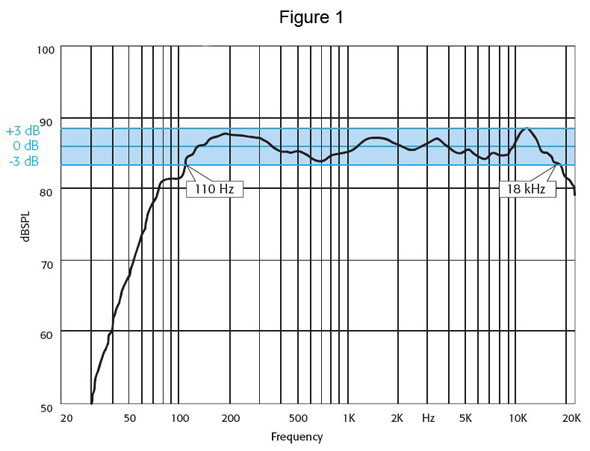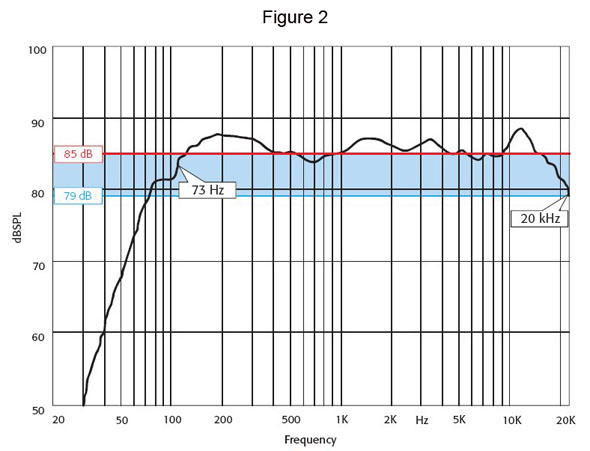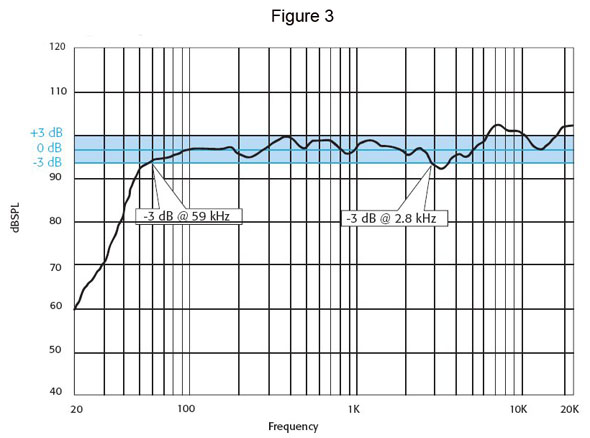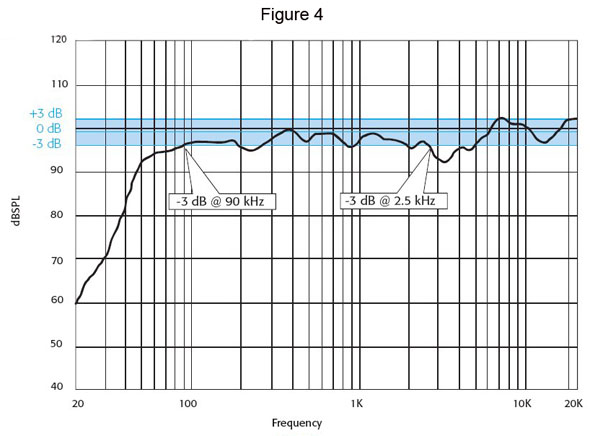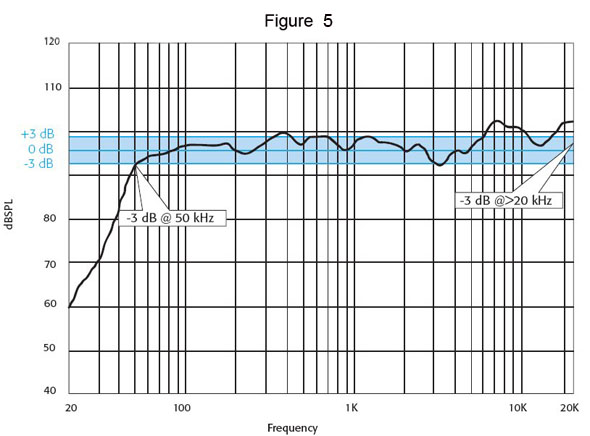The terms +/-3 dB and -6 dB are frequently (and erroneously) used interchangeably to characterize the frequency response of a loudspeaker system.
This has led to understandable confusion among consumers who may believe that a +/-3 dB specification is more rigorous than a -6 dB specification.
The purpose of this document is to explain the meaning of both specifications as they are commonly used (or misused) in pro audio today, and to provide a basis for comparing loudspeakers with differing stated specifications.
The term “+/-3 dB” originally expressed flatness – not high and low frequency extension. One could say, for example that “my speakers are flat – within +/-3 dB between 110 Hz and 18 kHz.” This means that between two frequencies, a frequency response graph of these speakers would not deviate by more than 3 dB in either direction from a straight line.
Figure 1 illustrates such a window superimposed on the frequency response curve of a small-format loudspeaker. Note that the response never rises above the window and falls below the window at 110 Hz and 18 kHz. This is a correct usage of the term +/- 3 dB. It is not how loudspeaker manufacturers use the term now.
The term “-6 dB” is meaningless without being referenced to something. And that something is the sensitivity of the loudspeaker which is typically expressed as “xx dB SPL, 1 watt @ 1 meter.”
Figure 2 shows the same loudspeaker represented in Figure 1. This loudspeaker has a sensitivity of 85 dB SPL, 1 watt @ 1 meter. The Frequency Response (-6 dB) figures are the points where the response curve crosses below 79 dB. So the Frequency Response (-6 dB) of this loudspeaker is 73 Hz – 20 kHz.
If +/-3 dB is an expression of flatness – not frequency response – what does it mean when used to characterize frequency response? To answer that question let’s look at the published specifications of a typical loudspeaker made by a manufacturer who labels Frequency Response as “+/-3 dB.”
The loudspeaker is specified as:
• Sensitivity (1 watt @ 1 meter) 99 dB SPL
• Frequency Response (+/-3 dB) 50 Hz – 20 kHz
Is the manufacturer trying to express the flatness of the loudspeaker? Figure 3 shows a +/-3 dB “flatness” window laid over the frequency curve so that the broadest possible range falls inside the window. In this instance, the curve crosses below the -3 dB line at 59 Hz and at 2.8 kHz. So clearly this loudspeaker is not flat (within +/-3 dB) from 50 Hz – 20 kHz.
Perhaps the manufacturer means that the +/-3 dB window is referenced to the 99 dB SPL sensitivity of the loudspeaker. In Figure 4 the window has been vertically centered at 99 dB. This yields a “frequency response” of 90 Hz – 2.5 kHz although the response does rise back into the window at 5 kHz.
In any event, this doesn’t come close to the claimed “Frequency Response (+/-3 dB) 50 Hz – 20 kHz.” If one ignores the slight dip at 100 Hz, it would be accurate to say that the “Frequency Response (-3 dB) is 90 Hz – 2.5 kHz.” It is unclear how to best characterize the region between 5 kHz and 20 kHz.
The only remaining option is to move the window so that -3 dB line of the window intersects the frequency curve at 50 Hz (Figure 5). Remember, the decibel always has to be referenced to something. If the response of the loudspeaker is 3 dB lower at 50 Hz, the question “3 dB lower than what?” has to be answered. In this case, the answer appears to be “3 dB lower than 96 dB SPL.”
But where did 96 dB SPL come from? 96 dB is 3 dB below the 99 dB nominal sensitivity of the loudspeaker. So this manufacturer is saying that “at 50 Hz, the frequency response is 3 dB plus another 3 dB below our sensitivity rating”. As you can see, none of this makes any sense.
In reality, this manufacturer is publishing a -6 dB Frequency Response specification and calling it out as a +/-3 dB specification. This is true of every other manufacturer surveyed as well.
The +/-3 dB specification originally was intended to express the flatness of a loudspeaker. Many manufacturers use it incorrectly to characterize the frequencies at which the response curve falls 6 dB below the nominal sensitivity. As commonly used +/-3 dB frequency response and -6 dB frequency response specifications should be understood to mean the same thing.
By the way, QSC publishes -10 dB Frequency Range specifications and -6 dB Frequency Response specifications. We have also published some -3 dB Frequency Response specifications that are true indications of the point at which the response falls 3 dB below the loudspeaker’s nominal sensitivity.
During the research for this document, at least one other manufacturer was found to be publishing a “-3 dB Frequency Response” specification. Examination of their published frequency curves indicated that this was in fact a -6 dB specification. Hopefully these errata will be corrected.
Finally, no matter how frequency response is expressed it is impossible to characterize with a pair of numbers. Such a specification can serve as only an extremely coarse indication of loudspeaker performance.
Gerry Tschetter works with QSC Audio.



